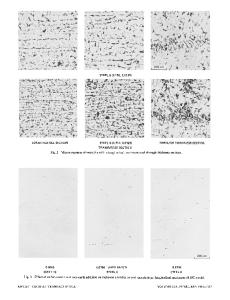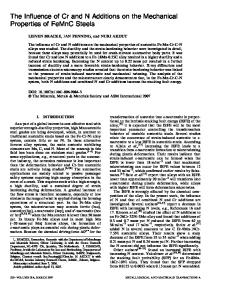Influence of Short Austenitization Treatments on the Mechanical Properties of Low-Alloy Steels for Hot Forming Applicati
- PDF / 2,586,846 Bytes
- 9 Pages / 593.972 x 792 pts Page_size
- 14 Downloads / 286 Views
DESPITE the continuing efforts utilizing alternative materials, steels remain the material of choice when it comes to structural and security-relevant components for automotive applications as they offer the possibility to widely tailor mechanical properties. For structural and security-relevant components, typically boron-alloyed steels are employed which are processed by an austenitization treatment in a furnace followed by subsequent press hardening by means of tool-quenching. After conventional press hardening, the boron-alloyed steels mostly exhibit a fully martensitic microstructure with high tensile strength and low ductility as shown by Karbasian and Tekkaya.[1] Furthermore, it was shown by Maikranz-Valentin et al.[2] that workpieces can be manufactured by press hardening, which exhibit tailored properties. In order to obtain excellent mechanical behavior of structural components, both high strength and high ductility are desired. By tempering the martensitic microstructures adjusted by press hardening, the ductility can be improved; however, the strength drops and thus a trade-off between either high MARTIN JOACHIM HOLZWEISSIG, Group Leader, and MIRKO SCHAPER, Professor, are with the Lehrstuhl fu¨r Werkstoffkunde (Materials Science), University of Paderborn, 33095 Paderborn, Germany. Contact e-mail: [email protected] JAN LACKMANN and STEFAN KONRAD, Research Engineers, are with the Research and Development, Benteler Automotive, 33102 Paderborn, Germany. THOMAS NIENDORF, Emmy-Noether Group Leader, is with the Institute of Materials Engineering, Technische Universita¨t Bergakademie Freiberg, 09599 Freiberg, Germany. Manuscript submitted January 5, 2014. METALLURGICAL AND MATERIALS TRANSACTIONS A
strength or high ductility has to be found. Therefore, new processing technologies and/or material concepts are currently in the focus of research in order to improve the crash performance of structural components. A promising approach to achieve this aim led to the development of flash processing of low-alloy steels, i.e., rapid heating, extremely short holding times at the austenitization temperature followed by a rapid cooling. Therewith, microstructures consisting of martensite and bainite can be adjusted, and thus, steels showing high strength and high ductility can be manufactured as demonstrated in the work of Lolla et al.[3] Recently Tung et al.[4] showed that steels with even better mechanical properties can be produced by this process. Furthermore, Azevedo et al.[5] demonstrated that due to the short austenitization durations, a fine bainitic product structure can be adjusted improving the mechanical properties, while Dlouhy et al.[6] proved this relationship for an austenite to martensite phase transformation. Cola[7] suggested that the main field of application for this process could be for armor and thus the flash processed products have a limited formability to date. However, in order to extend the field of applications of flash processed products, hot forming is of high interest for the industry especially r
Data Loading...










